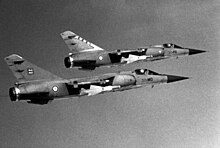Dassault Mirage F1
| Mirage F1 | |
|---|---|

| |
| A Spanish Air Force Mirage F1M | |
| Role | Fighter aircraft |
| National origin | France |
| Manufacturer | Dassault Aviation |
| First flight | 23 December 1966 |
| Introduction | 1973 |
| Status | Retired from the French Air Force operational service in June 2014. In limited service. |
| Primary users | French Air Force (historical) Iraqi Air Force (historical) Hellenic Air Force (historical) Spanish Air Force (historical) |
| Produced | 1966–1992 |
| Number built | 720[1] |
| Developed from | Dassault Mirage III |
The Dassault Mirage F1 is a French fighter and attack aircraft designed and manufactured by Dassault Aviation. It was developed as a successor to the popular Mirage III family.
During the 1960s, Dassault commenced development of what would become the Mirage F1 as a private venture, alongside the larger Mirage F2. Work on the F1 eventually took precedence over the more costly F2, which was cancelled during the late 1960s. The French Air Force (Armée de l'Air) took interest in the fledgling fighter to meet its requirement for an all-weather interceptor aircraft. Accordingly, initial production units were equipped with the Thomson-CSF Cyrano IV monopulse radar. During the latter half of 1974, the Mirage F1 entered service in the French Air Force. Shortly thereafter, the type was deployed as the main interceptor of the French Air Force, a capacity which it continued to serve in until the arrival of the Mirage 2000. It later transitioned to an aerial reconnaissance role. During June 2014, the last French Mirage F1s was retired from service.
Powered by a single SNECMA Atar 9K-50 turbojet engine, which provided about 7 tonnes-force (69 kN; 15,000 lbf) of thrust, and armed with an array of French and American-sourced armaments, the Mirage F1 has been operated as a light multipurpose fighter and has been exported to around a dozen nations. The type has seen action in a large number of armed conflicts involving several of its operators, including the Western Sahara War, the Paquisha War, the Cenepa War, the Iran–Iraq War, the Gulf War, the South African Border War, the War in Afghanistan, the Chadian–Libyan conflict, the 2011 military intervention in Libya, and the Northern Mali conflict. More than 720 Mirage F1s were manufactured between 1966 and 1992.[2] It was succeeded in production by the Dassault Mirage 2000.
Development[]
This section needs expansion. You can help by . (June 2017) |
The Mirage F1 emerged from a series of design studies performed by French aircraft manufacturer Dassault Aviation.[3] Having originally sought to develop a larger swept wing derivative of the Mirage III, which became the Mirage F2, to serve as a vertical take-off and landing (VTOL) propulsion testbed akin to the Dassault Mirage IIIV, however, it was soon recognised that the emerging design could function as the basis for a competent fighter as well. Both the Mirage F2 and a smaller derivative, referred to the Mirage F3, received substantial attention from both Dassault and the French Air Force, the latter being interested in its adoption as a long-range fighter bomber as a stopgap measure prior to the adoption of the envisioned Anglo-French Variable Geometry (AFVG) strike aircraft.[3]
Parallel with the Mirage F3 study, which was intended to serve as an interceptor aircraft, Dassault decided to study a single-seat derivative which featured the all-French SNECMA Atar 9K-50 turbojet engine.[3] As a result of the cancellation of two major projects, the company's design team found themselves with a decreased workload. Accordingly, in mid-1964, Dassault decided to commence design work on the smaller aircraft, subsequently designated as the Mirage F1, with the intention of producing a successor to its Mirage III and Mirage 5 fighters;[1][3] This work was performed under a government contract in anticipation of a potential French Air Force specification for an all-weather interceptor to succeed its fleet of Mirage IIIC aircraft.[3]
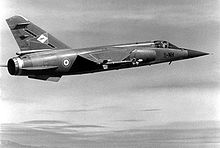
The Mirage F1 was of similar size to the delta-winged Mirage III and Mirage 5, and was powered by the same SNECMA Atar engine as had been used on the larger Dassault Mirage IV; however, unlike its predecessors, it shared the layout of a swept wing mounted high on the fuselage and a conventional tail surface as used by the F2.[4] Although it has a smaller wingspan than the Mirage III, the Mirage F1 nevertheless proved to be superior to its predecessor, carrying more fuel while possessing a shorter take-off run and superior maneuverability.[5]
On 23 December 1966, the first prototype conducted its maiden flight.[3] The first flight had been delayed due to a funding shortage affecting the overall programme. During its fourth flight, the prototype was recorded as having attained a top speed in excess of Mach 2.[3] On 18 May 1967, the first prototype was lost in an accident at DGA Essais en vol, Istres; the crash had resulted from a loss of control after encountering flutter, killing its pilot. Despite this misfortune, during late 1966, the Mirage F1 programme was officially adopted by the French Air Force.[3] Following a redesign period, on 20 March 1967, the second prototype performed its first flight.[3]
On 26 May 1967, an order for three Mirage F1 prototypes was placed, while the larger and more expensive Mirage F2 was formally abandoned.[4] These three pre-service aircraft, along with a static structural test airframe, soon joined the test programme. By late 1971, the construction of an initial batch of 85 production standard Mirage F1 had been authorised.[3]
In order to comply with the French Air Force's requirement for an all-weather interceptor, the first production Mirage F1C was equipped with a Thomson-CSF Cyrano IV radar system. The later Cyrano IV-1 version added a limited look-down capability.[6] However, Mirage F1 pilots reported that the radar was prone to overheating, which reduced its efficiency.[citation needed] During May 1973, the first deliveries to the French Air Force took place; the type entered squadron service with EC 2/30 Normandie-Niemen in December of that year.[7]
By October 1971, the Mirage F1 was under production at both Dassault's Bordeaux facility and at SABCA's own plant in Belgium, work at the latter having been performed under an industrial arrangement associated to Belgium's order for 106 Mirage 5 aircraft.[8] The 79 aircraft of the next production run were delivered during the period March 1977 to December 1983. These were of the Mirage F1C-200 version, which featured a fixed refuelling probe, which required an extension of the fuselage by 7 cm.
Design[]
This section needs expansion. You can help by . (June 2017) |
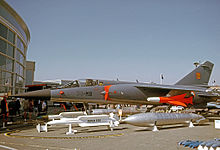
The Dassault Mirage F1 was a single-engine fighter aircraft, designed to function as both an interceptor aircraft and a ground attack platform.[1] While officially developed for the French Air Force as an air defense aircraft, Dassault had placed considerable emphasis on developing the Mirage F1 for ground attack duties as a secondary role during its early design.[3] Developed by the company to function as a successor to the successful Mirage III and Mirage 5 families, it drew heavily upon its predecessors as well, sharing the same fuselage as the Mirage III, while adopting a considerably different wing configuration.
The Mirage F1 used a shoulder-mounted swept wing, instead of the Delta wing of the Mirage III, which resulted in a more than 50% reduction in required runway lengths and increased internal fuel tankage for 40% greater combat range.[1][3] The approach speed prior to landing is 25% less than the preceding Mirage IIIE. According to Dassault, the negative performance impact associated with the increased thickness of the Mirage F1's wing over the Mirage III's counterpart had been offset by improvements made to the propulsion system.[3] The wing is fitted with both double-slotted trailing edge flaps and full-span leading edge slats, the latter being automatically operated to reduce the aircraft's turn radius during combat.[3]
A key area of advancement on the Mirage F1 over its predecessors was in its onboard avionics.[3] The Thomson-CSF Cyrano IV monopulse radar system, developed from the Cyrano II unit installed on the Mirage IIIE, serves as the main sensor; it operates in three different modes: air-target acquisition and tracking, ground mapping, and terrain avoidance.[9] The later Cyrano IV-1 model also provided for a limited look-down capability.[6] According to aerospace publication Flight International, the Cyrano IV radar was capable of detecting aerial targets at double the range of earlier models.[8] The standard production Mirage F1 was furnished with an Instrument Landing System (ILS), radar altimeter, UHF/VHF radio sets, Tactical Air Navigation system (TACAN) and a ground data link. Other avionics include an autopilot and yaw damper.[8]
The Mirage F1 was powered by a single SNECMA Atar 9K-50 turbojet engine, which was capable of providing roughly 7 tonnes-force (69 kN; 15,000 lbf) of thrust, giving the aircraft a maximum speed of 1,453 MPH and an altitude ceiling of 65,615 feet.[1] Flight International described the Atar engine as being "unexpectedly simple", despite the adoption of an afterburner.[8] An improved engine, initially known as the Super Atar and later as the Snecma M53, was intended to be eventually adopted on production Mirage F1 aircraft, as well as for successor aircraft.[8]
The initial armament of the Mirage F1 was a pair of internal 30 mm cannons, and a single Matra R530 medium-range air-to-air missile, which was carried under the fuselage.[10][11] It could carry a total combined payload of 13,889lb of bombs and missiles, all of which would be carried externally.[1][8] After 1979, the medium-range R530 was replaced by the improved Matra Super 530 F missile as the latter came into service in quantity with the French Air Force.[12] In 1977, the R550 Magic was released; the Mirage F1 has these missiles mounted on rails on the wingtips. Around the same time, the American AIM-9 Sidewinder was also introduced to the Mirage F1's armament; both the Spanish and Hellenic Air Forces had requested the integration of the Sidewinder upon their own Mirage F1CE and Mirage F1CG fighters.
Operational history[]
France[]
During 1984, the first operational deployment to be performed by French Air Force Mirage F1s was conducted during Operation Manta, the French intervention in Chad to counteract the growing Libyan encroachment in the region. A force of four Mirage F1C-200s provided air cover for a further group of four Jaguar strike aircraft; they also participated in a number of skirmishes against pro-Libyan Transitional Government of National Unity (GUNT) rebels.
In 1986, French Mirage F1s were redeployed to Chad as part of Operation Epervier. A flight of four F1C-200s provided fighter cover for a strike package of eight Jaguars during the air raid against the Libyan airbase at Ouadi Doum, on 16 February.[13] A pair of F1CRs also conducted pre and post-strike reconnaissance missions.[14]
In response to the Iraqi invasion of Kuwait, France performed two deployments of Mirage F1s to the Persian Gulf. In October 1990, 12 Mirage F1Cs were dispatched to Doha, Qatar in order to boost air defences, while a further four Mirage F1CRs of ER 33 were deployed to Saudi Arabia as part of Operation Daguet in September 1990.[15][16][17] To avoid the risk of being mistaken for hostile Iraqi Mirage F1s, all of the French F1CRs were grounded during the first few days of the Allied air attacks, flying their first combat mission on 26 January 1991; an additional reason for their initial grounding was the lack of compatible night vision equipment.[18][19] They were used in the fighter bomber role, using their more capable navigation systems to lead formations of French Jaguar fighter bombers, as well as to fly reconnaissance missions; in this capacity, 114 sorties had been flown by the end of hostilities.[15][1] Following the end of the Gulf War, France deployed a number of Mirage F1CRs to bases in neighbouring Turkey as part of Operation Provide Comfort to protect Kurds from Iraqi aggression.[15]
In November 2004, in response to an Ivorian air attack upon French peacekeepers, a force of three Mirage F1 jets launched an attack upon Yamoussoukro Airport, destroying a total of two Su-25 aircraft and three attack helicopters.[20]
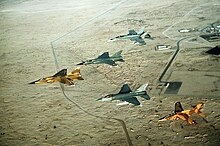
In October 2007, three Mirage 2000s and three Mirage F1s were deployed at Kandahar Air Force Base, where they flew close air support and tactical reconnaissance missions in support of international forces in Southern Afghanistan.[21][22]
The last French unit to be equipped with the Mirage F1 was the Escadron de Reconnaissance 2/33 Savoie, home-based at Mont-de-Marsan, which flew the latest version of the F1CR. The unit's primary mission was tactical reconnaissance, with a secondary mission of ground-attack; because of the unique missions of the 2/33, their unofficial motto among the pilots had become, "Find; Identify; and Photograph or Destroy." In accordance with a bilateral defense agreement between France and Chad, a pair of 2/33 F1CRs, along with 3 pilots, a photo interpreter, an intelligence officer and ground crews were always deployed to N'Djamena, Chad. The two 2/33 F1CRs operated with three Mirage 2000Ds, also based on rotation from France to Chad.[23]
During March 2011, 2/33 Mirage F1CRs were deployed to Solenzara Air Base, Corsica and conducted reconnaissance missions over Libya (also a Mirage F1 operator) as part of Opération Harmattan.[24] In 2013 2/33 F1CRs also participated in Operation Serval in Mali. On 10 January, launching from their base in N'Djamena in Chad, the first French air intervention mission against Islamist rebels in Mali, was undertaken by F1CRs and Mirage 2000Ds, supported by a French Air Force C-135K tanker. The 2/33 F1CRs provided valuable photo information for strike aircraft flying the next day from France. Later on 16 January, two 2/33 F1CRs, were deployed from Chad to Bamako, Mali. Both aircraft were fitted with extra long range 2,200 liter ventral tanks; and when operating over Mali also carried two 250 kg unguided bombs, plus their one internal 30mm cannon, in case they were called on for close air support missions.[25]
In order to replace the elderly F1CRs of 2/33s, a number of Rafales were outfitted with an advanced reconnaissance pod. The Rafale's range, maneuverability and combat load is far superior to the F1CR that it replaces, as well as its reconnaissance capabilities: after the Rafale's pod has taken photographs, these can be almost instantly transmitted back to its base or where the imagery would be required if provisioned with compatible down link equipment.[23] The French Air Force's last Mirage F1 fighters were retired from operational service on 13 June 2014. The last units in service, these being 11 single-seat Mirage F1CRs and three two-seat F1Bs were transferred to storage; six aircraft performed a final appearance in a flypast during Bastille Day celebrations over Paris prior to their disposal.[26]
Ecuador[]
Between 1979 and 1980, Ecuador received 16 F1JAs (a variant of the F1E) and a pair of F1JEs. The Ecuadorian Air Force's (FAE) squadron of Mirage F1JAs (Escuadrón de Caza 2112) went into action in January–February 1981 during the brief Paquisha War between Ecuador and Peru, less than two years after the aircraft had been delivered to the FAE. At that time, the Ecuadorians decided against directly challenging the Peruvian Air Force (abbreviated FAP), whose Mirage 5Ps and Sukhoi Su-22 were providing air cover to Peruvian heliborne operations within the combat zone. Instead, the Mirages were kept at a distance, performing combat air patrols (CAPs) on the fringes of the combat area, in case the border clashes escalated into wider hostilities. During one incident, a Peruvian Sukhoi Su-22 was intercepted and a single air-to-air R.550 missile was launched; however, it failed to strike the Peruvian aircraft.[27]

In 1995, during the Cenepa War, the Ecuadorian Mirages went back into action against Peru. This time, while the bulk of the squadron was kept back at Taura AFB, a small detachment of Mirage F1s and Kfir C.2s was deployed to undisclosed forward air bases to dissuade Peruvian attack aircraft from entering the combat zone. By this time, the planes had been upgraded with Israeli electronics and Python Mk.III air-to-air missiles, usually mounted on the outer underwing pylons, and Matra R550 Magic AAMs on wing-tip launch rails.[citation needed]
On 10 February 1995, a pair of Mirage F1JAs, piloted by Maj. Raúl Banderas and Capt. Carlos Uzcátegui, were directed over five targets approaching the combat zone in the Cenepa valley. After making visual contact, the Mirages fired their missiles, claiming two Peruvian Su-22Ms shot down, while a Kfir claimed a further A-37B Dragonfly.[28][29][30][31] Sources in Peru, however, deny the claim that the Sukhois Su-22Ms were shot down by Ecuadorian aircraft, stating that one was shot down by Ecuadorian anti-aircraft artillery fire during a low flying ground-attack mission, while the second was lost because of an engine fire.[32][33][34] Banderas served as Commander of the Ecuadorian Air Force between May 2014 and February 2016, while Uzcátegui died in a training accident in 2002 at Salinas air base, in the Santa Elena Province.[35][36][37][38]
In 2011, all of the remaining Ecuadorian Mirage F1s still in service were retired after having flown more than 33,000 flight hours during their 32 years in active service; they were replaced by a squadron of Atlas Cheetah fighters bought from South Africa.[39]
Iraq[]
During the late 1970s, Iraq placed an order for a variant of the Mirage F1, designated as the Mirage F1EQ, which was specially modified for extended range to perform strike missions and was dissimilar to any of the models operated by the French Air Force.[40] During this period, France was a major supplier of military equipment to the nation; in 1983, the former loaned several Dassault-Breguet Super Étendard to Iraq while the latter was awaiting the delivery of the Mirage F1EQ, which experienced a protracted development period and thus the delay of deliveries.[41] The Super Étendard had been strongly advocated for by Dassault, who had feared the potential cancellation of the sizable Mirage F1 order by Iraq if the request was not granted.[42]
In 1982, it was agreed to reconfigure several of the under-order Iraqi Mirages F1s from a general combat configuration into a dedicated ground attack platform, adopting Thomson-CSF-built sophisticated electronic warfare equipment and a vastly-increased payload capacity, which included the newly developed AS-30 air-to-surface missile.[43] In this role, the Mirage F1 was used to replace Iraq's aging fleet of Hawker Hunters.[44] In September 1985, an agreement was signed between Dassault and Iraq for the delivery of a further 24 aircraft.[45]
During the Iran–Iraq War, Iraq's Mirage F1EQs were used intensively for interception, ground attack and anti-shipping missions.[46] The Mirage F1EQ allowed for Iraqi strikes to be conducted over a greater combat radius into Iran than had been previously possible.[47] In November 1981, an Iraqi Mirage F1 accounted for the first Iranian F-14 Tomcat to be shot down, followed by several more in the following months, giving the previously timid Iraqi Air Force new confidence in air-to-air combat engagements with the Iranians.[48] According to research by journalist Tom Cooper, during the war 33 Iraqi Mirage F1s were shot down by Iranian F-14s[49] and two were downed by Iranian F-4 Phantom II units.[50] Iraqi F1EQs claimed at least 35 Iranian aircraft, mostly F-4s and Northrop F-5E Tiger IIs, but also several F-14 Tomcats.[51][page needed]
On 14 September 1983, a pair of Turkish Air Force F-100F Super Sabre fighter jets of 182 Filo “Atmaca” penetrated Iraqi airspace. A Mirage F-1EQ of the Iraqi Air Force intercepted the flight and fired a Super 530F-1 missile at them. One of the Turkish fighter jets (s/n 56-3903) was shot down and crashed in Zakho valley near the Turkish-Iraqi border. The plane's pilots reportedly survived the crash and were returned to Turkey. The incident was not made public by either side, although some details surfaced in later years. The incident was revealed in 2012 by Turkish Defence Minister İsmet Yılmaz, in response to a parliamentary question by Republican People's Party (CHP) MP Metin Lütfi Baydar in the aftermath of the downing of a Turkish F-4 Phantom II in Syria, in 2012.[52]
On 17 May 1987, an Iraqi Mirage F1 fired a pair of Exocet missiles at the United States Navy (USN) warship USS Stark as it patrolled the Persian Gulf, causing extensive damage to the ship, killing 37 and wounding 21 members of Stark's crew. The exact motive and orders of the pilot remain unclear, although Iraq later apologized for the attack, referring to the incident as "a mistake" and blaming Iran.[53]
Prior to the outbreak of the 1991 Gulf War, Iraq's Mirage F1EQ fleet was the second most numerous type operated by the Iraqi Air Force (the most numerous being the MiG-21).[54] On 17 January 1991, during the opening minutes of the conflict, an unarmed, United States Air Force (USAF) EF-111, crewed by Captain James A. Denton and Captain Brent D. Brandon scored a kill against an Iraqi Mirage F1EQ, which they managed to maneuver into the ground, making it the only F-111 to achieve an aerial victory over another aircraft.[55] Later in the war, an Iraqi Mirage piloted by Capt. Nafie Al-Jubouri successfully downed an American EF-111 Raven through aerial maneuvering as it crashed while attempting to avoid a missile fired by Al-Jubouri.[56][57]
Coalition forces shot down several Iraqi F1s during the Gulf War, such as six F1EQs that were shot down by USAF F-15 Eagles. A pair of F1EQs, which were preparing to carry out a Beluga cluster bomb attack on Saudi oil facilities were shot down by a Royal Saudi Air Force (RSAF) F-15C.[58][59] Of a pre-conflict force of 88 Mirage F1EQs, 23 were destroyed in the war, a further six were damaged, 24 were flown to Iran and interned; only 23 aircraft remained in service by the end of the Gulf War.[1] Of the 23 destroyed Iraqi Mirage F1EQs, 9 were claimed to have been destroyed in aerial combat.[44]
Morocco[]
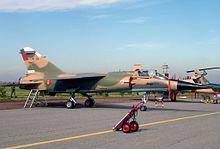
During 1975, a large order for 30 Mirage F1CHs and 20 Mirage F1EHs was placed by the Royal Moroccan Air Force (RMAF) with Dassault, the first of which to be delivered during 1978. Upon delivery, these were grouped into two squadrons, one focusing on ground-attack operations and the other upon air defence; comprising over a third of its fighter force, the Mirage F1 served as the primary air defence fighter of the RMAF for the next two decades.[60] As early as 1979, these aircraft were engaged in combat missions against the forces of the Polisario Front, operating in Western Sahara. The RMAF lost seven Mirages as a result of hostile fire, along with a further six which had crashed due to different mishaps. Three Mirage pilots were killed and three were captured.[61] According to politics author Anthony Cordesman, the RMAF has struggled to effectively service and operate all of its Mirage F1s, possibly due to a lack of funding for spare parts.[62]
South Africa[]
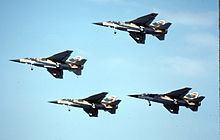
During 1971, South Africa commenced its search for a replacement for the Mirage III; as a result, it chose to purchase a licence to manufacture both the Mirage F1 and its engine with the intention of producing up to 100 Mirage F1s. However, this license was quickly cancelled as a consequence of the impending 1977 arms embargo. The SAAF proceeded to procure 16 Mirage F1CZs and 32 Mirage F1AZs, which were quickly delivered by Dassault prior to the embargo being implemented, the first of these deliveries occurring in 1975.
Both the F1CZ and F1AZ variants of the South African Air Force (SAAF) saw considerable action during operations in the Border War. In November 1978, the first five F1CZs were deployed to South-West Africa (Namibia), tasked with providing escort for reconnaissance flights over Southern Angola. From 1980, such deployments as escort aircraft became regular. Due to teething problems with the F1AZ, F1CZs were initially assigned the strike role in southern Angola using Matra M155 rocket pods or 250 kg bombs.[citation needed]
F1CZs of 3 Squadron downed two Angolan MiG-21s in 1981 and 1982. On 6 November 1981, during Operation Daisy, two F1CZs were vectored by GCI to intercept two MiG-21s heading south. Major Johan Rankin shot down the wingman with cannon fire, as the missiles failed to lock on to the MiGs. On 5 October 1982, while escorting a Canberra of 12 Squadron on a photo-reconnaissance sortie, Rankin and his wingman engaged two MiG-21s on an intercept course. He fired two Magic AAMs at one of the MiGs, damaging the aircraft with the second missile. Rankin then attacked the second MiG and destroyed it with cannon fire.[63] The first MiG was able to return to base, but sustained additional damage making a belly landing.
In May 1982, an Angolan Mi-8 helicopter that the SADF believed to be carrying senior officers was located and destroyed in the Cuvelai area. The helicopter was located with rotors running on the ground by a pair of F1CZs and destroyed by 30mm cannon fire.[citation needed]
Two F1AZs of 1 Squadron were lost over Angola. On 20 February 1988, while flying an interdiction sortie in F1AZ '245' against a road convoy during Operation Hooper, Major Ed Every was shot down by an SA-13 Gopher SAM. F1AZ '223' was lost almost a month later, on 19 March, when Captain Willie van Coppenhagen flew into the ground while returning from a diversionary strike at night.; a SAAF Board of Inquiry was unable to determine the causes of the crash.[63][64]

Two F1AZs and a F1CZ were also damaged by enemy action, but were able to return to base. On 7 June 1980, while attacking SWAPO's Tobias Haneko Training Camp during Operation Sceptic (Smokeshell), Major Frans Pretorius and Captain IC du Plessis were both hit by SA-3 Goa SAMs. Du Plessis' aircraft was hit in a fuel line and he had to perform a deadstick landing at AFB Ondangwa. Pretorius's aircraft sustained heavier damage and had to divert to Ruacana forward airstrip, where he landed with only the main undercarriage extended. Both aircraft were repaired and returned to service.[63] During the last phase of the Bush war 683 combat sorties were flown by the F1AZs, and more than 100 SAM's were fired at them.[citation needed]
On 27 September 1987, during Operation Moduler, an attempt was mounted to intercept two Cuban FAR MiG-23MLs. Captain Arthur Piercy's F1CZ was damaged by either an AA-7 Apex or AA-8 Aphid AAM fired head-on by Major Alberto Ley Rivas. The explosion destroyed the aircraft's drag chute and damaged the hydraulics. Piercy was able to recover to AFB Rundu, but the aircraft overshot the runway. The impact with the rough terrain caused Piercy's ejection seat to fire; he failed to separate from the seat and suffered major spinal injuries.[63]
In February 1987, three F1AZs fired several V-3B missiles at a group of MiG-23s without success. This was repeated again in February 1988 when a F1AZ fired a missile at a MiG-23 and fired 30mm cannon, again without success. Various other unsuccessful attempts were made during the 1987–88 period.
Apart from operations from Namibia in July 1981, a pilot of the Mozambican Air Force defected with his MiG-17. He flew from his base near Maputo towards South Africa. Two F1AZs returning from a training exercise intercepted the MiG-17. In March 1981 two F1AZs intercepted a Zimbabwean Army CASA C-212 and forced it to land in South Africa after asserting that the aircraft had strayed into South African airspace.[citation needed]
The SAAF lost an additional six F1AZs and three F1CZs to various mishaps. F1CZ '205' caught fire after landing and was repaired using the tail section of F1CZ '206' (Piercy's aircraft).[63]
Spain[]
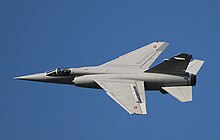
In June 1975, with tension growing with Morocco, Spain decided to strengthen its Air Force and bought 15 Mirage F1C that were allocated to Albacete AB. In mid-1976 there was still some tension with Morocco and Algerian and Libyan MiG-25 flights on the Mediterranean, which would lead the Spanish Air Force to purchase ten more Mirage F1C and two years later order 48 Mirage F1C and F1E.[citation needed]
Some years later Spain also bought 12 F1EDA/DDA's retired from Qatar Air Force, which donated some equipment and weapons used by those Mirage F1s. In Spanish service the F1CE was known as the C.14A, the F1EE was the C.14B and the two-seater F1EDA as the C.14C.
They served mainly as Spain's primary air defence interceptors and interdiction as secondary role until they were superseded by Spain's EF-18A Hornets. They served with Ala 11 (11th Wing) in Manises (Ex-Qatari planes), Ala 14 in Albacete, and Ala 46 at Gando in the Canary Islands.[65] Ala 46 used their Mirage F1s mainly as air defence planes, using same deep blue color pattern as French planes.
In October 1996, Thomson-CSF was awarded a FFr700 million (US$96m) contract to upgrade 48 F1C/E single-seaters and 4 F1EDA trainers to Mirage F1M standard (see below). Ex-Qatar Mirage F1s were left outside the upgrade, as it was a different version, and were the first ones to be retired.[66] As well as a service-life extension, this improved the avionics and added anti-shipping capability with a modernised Cyrano IVM radar and Exocet compatibility.
From July 2006 to November 2006, Spanish Mirage F1s were deployed to Lithuania as a part of NATO's Baltic Air Policing mission; during this deployment, they were scrambled twice to intercept undisclosed intruders. On 20 January 2009, a pair of Spanish F1s from the 14th Wing crashed near their base during a routine Spanish Air Force dogfight training mission, resulting in the deaths of all three crew members. The wreckage of the two jets, including the remains of the aircrew, was found about 3 km (1.9 mi) apart.[67] By 2009, there were 38 F1M's in service with Escuadrón 141 (141st Squadron) "Patanes" and Escuadrón 142 (142nd Squadron) "Tigres" of Ala 14.[65]
In 2013, the Spanish Air Force retired its fleet of Mirage F1s,[68] having progressively phased the type out of service as increasing numbers of the Eurofighter Typhoon had become available.[65] During 2013, it was reported that Spain may sell sixteen F1M's to Argentina but it seems they now have the budget to buy new Kfirs instead.[69] The deal went through and Argentina bought the Spanish Mirages in October 2013,[70] but the deal was scrapped in March 2014 after pressure from the United Kingdom on Spain to not assist in FAA modernization over tensions between the countries over the Falkland Islands.[71] In November 2017, Draken International announced that it had acquired 22 F1Ms from Spain and would refurbish and upgrade them for use as adversary aircraft.[72]
Libya[]
Libya procured 36 Mirage F1ADs to equip the Libyan Air Force, functioning as an air superiority fighter.[73] The base F1AD model is a specialized strike variant that lacks the standard radar unit; it is instead outfitted with a retractable fuel probe mounted on the nose. Four F1ADs were subsequently upgraded into a multirole configuration.[73]
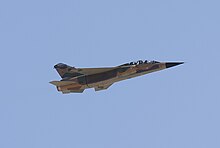
Libyan Mirage F1s participated in the war in Chad intensively and proved its worth during the Libyan campaigns during both 1981 and 1983; however, they were not used later as the Air Force held them back for an eventual anticipated confrontation with the US and its allies. In August 1981, a large group of 70 Libyan aircraft, including Mikoyan-Gurevich MiG-23s, MiG-25s, Sukhoi Su-20s, Su-22Ms and Mirage F1s, approached a US Navy carrier battle group as a show of strength, they were escorted until their withdrawal from its vicinity by 14 McDonnell Douglas F-4 Phantom IIs and Grumman F-14 Tomcats.[74]
When operating in Chad, the Mirage F1ADs a typical combat configuration consisted of a pair 1.300 litre drop tanks and a pair of Belouga CBUs. Operations were performed almost exclusively during daylight hours and from high altitudes, which resulted in limited effectiveness.[75] From 1981, a detachment was deployed at Marten es-Serra in southern Libya; from 1983, these Mirage F1s were regularly detached also to Faya-Largeau, in central northern Chad. Together with Mirage 5s, Mirage F1s were instrumental in the huge success enjoyed during different campaigns against the Chadian troops in the early 1980s: operating over the open and barren desert terrain, they caused heavy damage, making any larger troop movements very costly, for no losses in exchange.
The Mirage F1 fleet saw action during the 2011 Libyan Civil War. The Libyan Air Force posed little threat to coalition forces, partially as a result of insufficient equipment and a heavy reliance upon older aircraft acquired from the Soviet Union, but remained effective against poorly armed anti-Gaddafi rebels.[75] On 21 February 2011, a pair of Libyan aircraft landed in Malta after they had been ordered to bomb protesters in Benghazi; both of the pilots claimed political asylum.[73] Following the death of Muammar Gaddafi and the end of the civil war, France and Libya formed an agreement in 2012 to modernise the remaining Mirage F1 fleet, as well as covering the potential purchase of additional Mirage F1s that had been formerly operated by the French Air Force.[76]
Variants[]
Mirage F1A[]
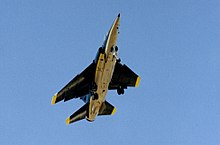
Single-seat ground-attack fighter aircraft, with limited daylight-only air-to-air capability. Fitted with lightweight EMD AIDA 2 ranging radar instead of Cyrano IV of other variants, with laser rangefinder under nose, retractible refuelling probe and more fuel.[77][78]
- Mirage F1AD : Mirage F1A for Libya. 16 delivered 1978–1979.[79]
- Mirage F1AZ : F1A for South Africa. 32 delivered 1975–1976.[80]
Mirage F1B[]
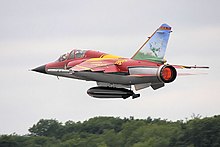
The French Air Force also ordered 20 Mirage F1Bs, a two-seat operational conversion trainer; these were delivered between October 1980 and March 1983.[81] The extra seat and controls added only 30 cm (12 in) to the length of the fuselage, but at the cost of less internal fuel capacity and the loss of the internal cannon.[11]
The empty weight increased by 200 kg (440 lb),[11] partly due to the addition of two Martin-Baker Mk 10 zero-zero ejection seats, in place of the Mk 4 used in the F1C, which had a forward speed limitation.
In all other aspects the F1B is a combat-capable aircraft and it can compensate for lost capacity with cannon pods and drop tanks.
- Mirage F1BD : Export version of the Mirage F1D for Libya. Six delivered 1978–1979.[79]
- Mirage F1BE : Mirage F1B for Spain, local designation CE.14A. Six delivered 1980–1981.[82]
- Mirage F1BJ : Mirage F1B for Jordan. Two built.[83]
- Mirage F1BK : Export version of the Mirage F1B for Kuwait. Two built.[79]
- Mirage F1BK-2 : Multi-role two-seater for Kuwait, equivalent to F1Dl. Four built.[79]
- Mirage F1BQ : Two-seat trainer for Iraq, some of which fitted with dummy flight refuelling probe. 18 ordered of which 15 were delivered between 1980 and 1989.[84]
Mirage F1C[]

- Mirage F1C : Production interceptor version for the French Air Force
- Mirage F1C-200 : Designation for F1Cs fitted with refueling probe.
- Mirage F1CE : Export version of the Mirage F1C for Spain, with local designation C.14A. 45 purchased in three batches, delivered between 1975 and 1981.[82]
- Mirage F1CG : Export version of the Mirage F1C for Greece. 40 built, which were delivered between 1975 and 1978.[27]
- Mirage F1CH : Export version of the Mirage F1C for Morocco. 30 built, delivered 1978–1979.[85]
- Mirage F1CJ : Export version of the Mirage F1C for Jordan. 17 built.[83]
- Mirage F1CK : Export version of the Mirage F1C for Kuwait. 18 built and delivered 1976–1977. Later upgraded to CK-2 standard.[79]
- Mirage F1CK-2 : Nine multi-role aircraft, equivalent to the F1E, were sold to Kuwait as part of a follow up order.[79]
- Mirage F1CR : Upgraded F1C for the French Air Force to replace the Mirage IIIR in the tactical reconnaissance role.
- Mirage F1CT : Upgraded F1C-200 for the French Air Force to replace the Mirage IIIE in the close air support role.
- Mirage F1CZ : Export version of the Mirage F1C for South Africa. 16 delivered 1974–1975, with two further aircraft received to replace aircraft lost in a February 1979 collision.
- Mirage F1ED : Export version of the Mirage F1C for Libya. 16 built.
Mirage F1D[]
Two-seat training version, based on the Mirage F1E multi-role fighter, ground-attack aircraft.
- Mirage F1DDA : Export version of the Mirage F1D for Qatar. Two built.
Mirage F1E[]


Single-seat all-weather multi-role fighter and ground-attack aircraft.
- Mirage F1JA : Export version of the Mirage F1E for Ecuador. 16 built.
- Mirage F1EE : Export version of the Mirage F1E for Spain. 22 built.
- Mirage F1EH : Export version of the Mirage F1E for Morocco. 14 built.
- Mirage F1EH-200 : Moroccan aircraft fitted with a flight refuelling probe. Six built.
- Mirage F1EJ : Export version of the Mirage F1E for Jordan. 17 built.
- Mirage F1EQ : Export version of the Mirage F1E for Iraq. 16 built.
- Mirage F1EQ-2 : Single-seat air defence fighter version for Iraq. 16 built.
- Mirage F1EQ-4 : Single-seat multi-role fighter, ground-attack, reconnaissance version for Iraq. 28 built.
- Mirage F1EQ-5 : Single-seat anti-shipping version for Iraq. 20 built.
- Mirage F1EQ-6 : Single-seat anti-shipping version for Iraq. 30 built.
- Mirage F1EDA : Export version of the Mirage F1E for Qatar. 12 built.
Mirage F1CG[]
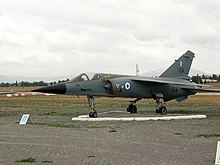
Greece operated 40 Dassault Mirage F1CG single seat aircraft. F1CG was first ordered in 1974 and entered service with the Hellenic Air Force in 1975[87] The aircraft were used by 334 Squadron and 342 Squadron.[88] Mirage F1CG was armed with the Sidewinder AIM-9P missile, rather than the most commonly used Matra Magic II, and it could carry four AIM-9Ps, rather than just two.[87]
The Hellenic Air Force retired the remaining 27 Mirage F1CGs on 30 June 2003 after 28 years of service and 160 000 flying hours.[87] A number of F1CG aircraft have been preserved, permanently grounded, for display. At least four are preserved in Tanagra (LGTG), Greece (115, 124, 129 and 140).[89][90] One more (134) is preserved at HAF History Department, Delta Falirou.
Mirage F1CR[]

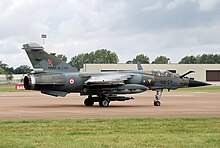
When it became clear that the Mirage F1 was becoming a successful production aircraft, Dassault began investigating the possibility of a dedicated reconnaissance version for its most important client, the French Air Force. However, the escalating cost of fighter aircraft meant that add-on pods for this purpose were a more economical alternative.
Many French Air Force aircraft, as well as those of some export clients (such as Iraq's Mirage F1EQ), did indeed have a variety of reconnaissance pods available, which were attached to the underside of the main fuselage. However, the development of a tactical reconnaissance aircraft for the French Air Force continued, and the first Mirage F1CR-200 flew on 20 November 1981.[91]
The Mirage F1CR carries reconnaissance equipment, internally and externally:[92]
- A SAT SCM2400 Super Cyclone infrared linescan unit is installed in the space previously occupied by the port cannon.
- A space under the nose can be used for a Thomson-TRT 40 panoramic camera or a Thomson-TRT 33 vertical camera.
- The Cyrano IVM-R radar has extra ground- and contour-mapping modules.
- A variety of sensors can be carried in external pods carried under the fuselage centreline. These include the Raphaël TH Side-Looking Airborne Radar (SLAR), the ASTAC ELINT pod and the RP35P optical reconnaissance pod.[93]
A total of 64 Mirage F1CRs were ordered by the French Air Force.[81] The first air force unit equipped with the CR was Escadron de Reconnaissance 2/33 which became operational in September 1983.[94]
Mirage F1CT[]
The Mirage F1CT is a ground attack version of the Mirage F1C-200. Following their replacement in the air defence role by the Mirage 2000, the French Air Force had a number of surplus Mirage F1C-200s, and in 1988 it launched a conversion programme to turn these aircraft into interim ground attack aircraft to replace elderly Mirage IIIEs and Mirage 5s.[95] The Mirage F1CT program brought the avionics of the F1C up to the standard of the F1CR, with the radar upgraded with the additional air-to-ground modes of the Cyrano IVM-R, an improved navigation/attack system fitted, with a laser rangefinder fitted under the nose. It was fitted with new Mk 10 ejection seats, while improved radar detection and warning devices, chaff/flare dispensers, and secure radios were also added.[96] It gained the ability to carry a variety of air-to-ground weapons, including rockets, cluster bombs and laser-guided bombs, while retaining the F1Cs air-to-air armament.[97]
Two prototypes were converted by Dassault, the first flying on 3 May 1991, with a further 55 converted by the workshops of the French Air Force at Clermont Ferrand by 1995.[95][98]
Mirage F1AZ and F1CZ[]
This section needs additional citations for verification. (August 2009) |
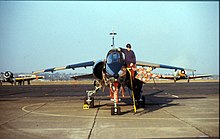
The South African Air Force (SAAF) flew both the Mirage F1AZ ground-attack version as well as the radar-equipped Mirage F1CZ fighter. The first two examples of the first order (48 aircraft, comprising 32 F1AZ and 16 F1CZ) were delivered on 5 April 1975. In July of that year, the remainder of the F1CZs were delivered and 3 Squadron was recommissioned to operate the aircraft from AFB Waterkloof. In 1975 the F1CZs also appeared at a South African airshow, the public were not informed that it was already in service.[citation needed]
The F1AZ was developed in conjunction with Dassault and the SAAF as a dedicated ground attack variant. The F1AZs were delivered between November 1975 and October 1976 and were assigned to 1 Squadron. Paramount Group, a South African-based company owns the intellectual property for the Mirage F1AZ.
The F1AZ has a laser-based rangefinder, permitting the highly accurate fusing and aiming of unguided munitions, such as bombs and rockets. Optical design was by the Optics (later ELOPTRO) division of Armscor in South Africa. The F1AZ features an integrated ground-attack system, comprising two on-board computers that can identify targets at a distance of 5 km. A laser range finder, situated below its conical nose, is connected to the computers to provide them with target info without emitting radar signals. After target identification and information gathering, bombs are automatically released at the right moment, known as CCRP, or 'Computer Controlled Release Point'.[citation needed] While the range-finding ability of the EMD AIDA 2 radar permits the use of combat and visual interception missiles, the helmet-mounted sight element enables the pilot to make off-boresight engagements, without waiting until achieving an optimum firing position. The F1AZ is equipped with two internal DEFA 30mm cannons with 125 rounds each, and carries a wide variety of external ordnance, including various types of bombs, cluster munitions, missiles, and rocket launchers.[citation needed]
The SAAF retired the F1CZs in 1992, followed by the F1AZs in 1997.[citation needed]
Despite their retirement in 1997, the accuracy of the F1AZ's armament delivery is still considered classified information by the SAAF; analysis by informed news services (e.g., Jane's Defence Weekly) and pilot reports (e.g., Commandant Dick Lord, 'Vlamgat', 1999) conclude that the F1AZ has accuracies within the order disclosed by the USAF for their F-15E Strike Eagle in unguided ballistic mode.[99]

In 2004, up to 21 F1AZs were reported in storage at AFB Hoedspruit, awaiting a possible buyer. In April 2006, it was reported that Aerosud had purchased the surviving Mirage F1AZs and spares.
South Africa granted Aerosud a contract to fit the Dassault Mirage F1 with the Klimov RD-33 engine used in the MiG-29 fighter.[100] Although overtaken by the decision of the South African Air Force to buy the SAAB JAS 39 Gripen, the upgrade was technically successful.
On 17 August 2006, French news agency Agence France-Presse (AFP) reported that two upgraded ex-South African F1AZs had taken part in a fly-past over Libreville earlier that day in celebration of Gabon's independence day. The refurbishment and upgrade of the aircraft was carried out by Aerosud. Aerosud Group managing director Dr. Paul Potgieter confirmed his company's involvement, but declined to give numbers or cite figures.[citation needed]
Mirage F1 M53[]
Developed for the participation in the "European" NATO fighter competition of early seventies, seeking to replace the F-104G. It was equipped with a more powerful engine, the SNECMA M53, and other improvements. Failed to succeed, the contest was eventually won by the General Dynamics F-16. The Mirage F1 came in second place[101]
Mirage F1M[]
The F1M upgrade (unrelated to the M-53 prototype) was applied to 48 Spanish F1CE/EE and four F1EDA trainers under a FFr700 million (US$96m) contract awarded to Thomson-CSF in October 1996.[66] The prototype F1M flew in April 1998, and CASA delivered the remainder between March 1999 and 15 March 2001.[66] The project included a revised cockpit with colour LCDs and a Smart HUD from Sextant Avionique, a Sextant inertial navigation system with GPS interface; NATO-compatible Have Quick 2 secure communications; Mode 4 digital IFF; a defensive aids suite; and flight recorders.[66] The radar was upgraded to Cyrano IVM standard, adding sea search and air to ground ranging modes.
Mirage F1 MF2000[]
The Royal Moroccan Air Force started in 2005 the 350 million euro MF2000 upgrade program to modernise 27 F1CH, F1EH and F1EH-200 aircraft. Changes included replacement of the old Cyrano IV radar by a RC400 (RDY-3) radar based on that used by the Mirage 2000-5, a revised cockpit, and improved armament, with Damocles targeting pods, MICA air-to-air missiles and AASM guided bombs added.[102] This upgrade was performed by ASTRAC (Association Sagem Thales pour la Rénovation d'Avions de Combat).[103]
Operators[]

The Dassault Mirage F1 has been operated by fourteen air forces, with four of them still doing so. Out of these, three have been European, five Middle Eastern (with one still flying the type), and four African (three still operating it).
Current operators[]
 Gabon
Gabon
- Gabonese Air Force received 6 F1AZ aircraft from South Africa, with two more to be delivered.
 Iran
Iran
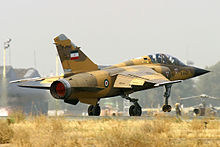
- Islamic Republic of Iran Air Force seized 24 F1BQs and F1EQs flown over from Iraq, during the 1991 Persian Gulf War.
 Libya
Libya
- Libyan Air Force received 16 F1AD, 6 F1BD & 16 F1ED aircraft. All were grounded but twelve were contracted for refurbishment, of which only four were returned to service.[104] Of these twelve, two were taken to Malta when their pilots defected.[105][106] France will renovate Libya's small fleet of Mirage F1s and train its personnel as part of a defence co-operation agreement signed in 2012. Three Mirage F1 were reported lost during the western 2019 offensive.[107][108][109]
 Morocco
Morocco
- Royal Moroccan Air Force received 30 F1CHs, 14 F1EHs & 6 F1EH-200s. 23 are still operational and 27 have been upgraded to ASTRAC.[110]
Non-government/private military operators[]
- Paramount Aerospace Systems acquired four former French Air Force Mirage F1B.[111]
 United States
United States
- Draken International has acquired 20 former Spanish Air Force Mirage F1Ms and 2 F1B aircraft for use in the Adversary Air role providing support to the United States Air Force. One plane was lost when it crashed on May 24, 2021.[112]
- Textron subsidiary Airborne Tactical Advantage Company in 2017 acquired 63 former French Air Force Mirage F1B, F1CT, and F1CR for dissimilar air combat training and aggressor squadron purposes for the US Air Force.[113][114] The intention is to have between 30 and 45 of them airworthy.[115]
Former operators[]
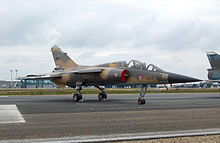
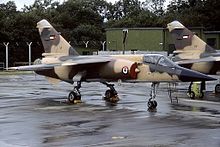
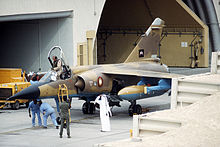
 Ecuador
Ecuador
- Ecuadorian Air Force operated 16 F1JA & 2 F1JE. During their operational service, at least three of these aircraft were confirmed as lost in accidents. In February 2011, the remaining aircraft in the squadron were retired from service.[116]
 France
France
- French Air and Space Force received 246 aircraft. The last squadron flying the aircraft was officially disbanded on 13 June 2014.[117]
 Greece
Greece
- Hellenic Air Force operated 40 F1CG.
 Iraq
Iraq
- Iraqi Air Force received 106 F1EQ & 15 F1BQ between 31 January 1981 and 1989, with a further 4 EQs and 4 trainers undelivered due to Iraq's inability to pay and the UN arms embargo[118] imposed following the 1990 invasion of Kuwait.[84] In early 2011, the French government offered to update and refurbish 18 French-held F1 Mirages and sell these to the Iraqi Air Force.[119]
 Jordan
Jordan
- Royal Jordanian Air Force received 17 F1CJ, 17 F1EJ & 2 F1BJ. In 2010 it was reported that Argentina might lease twelve F1CJ's and an F1BJ but nothing came of it.
 Kuwait
Kuwait
- Kuwait Air Force operated 27 F1CK & 6 F1BK.
- Libyan Air Force (1951–2011). Passed on to successor government.
 Qatar
Qatar
- Qatar Air Force operated 13 F1EDA & 2 F1DDA. 13 were sold to Spain.[120]
- South African Air Force operated 32 F1AZ & 16 F1CZ.
 Spain
Spain
- Spanish Air Force received originally 45 F1CE, 22 F1EE & 6 F1BE. Also acquired 24 second-hand examples from France and Qatar in the early 1990s. Spanish F1s were deployed in 2006 for Baltic Air Policing mission. Finally, Spain decommissioned its Mirage F1 fleet in February 2013.
Specifications (Mirage F1)[]



Data from Jane's All The World's Aircraft 1988–89,[121]
General characteristics
- Crew: 1
- Length: 15.3 m (50 ft 2 in)
- Wingspan: 8.4 m (27 ft 7 in)
- Height: 4.5 m (14 ft 9 in)
- Wing area: 25 m2 (270 sq ft)
- Empty weight: 7,400 kg (16,314 lb)
- Gross weight: 10,900 kg (24,030 lb) (clean take-off weight)
- Max takeoff weight: 16,200 kg (35,715 lb)
- Powerplant: 1 × SNECMA Atar 9K-50 afterburning turbojet engine, 49.03 kN (11,020 lbf) thrust [122] dry, 70.6 kN (15,900 lbf) with afterburner
Performance
- Maximum speed: 2,338 km/h (1,453 mph, 1,262 kn) at 11,000 m (36,089 ft)[122]
- Maximum speed: Mach 2.2
- Combat range: 425 km (264 mi, 229 nmi) hi-lo-hi at Mach 0.75/0.88 with 14 × 250 kg (551 lb) bombs
- Ferry range: 3,300 km (2,100 mi, 1,800 nmi) with maximum external fuel[123]
- Endurance: 2 hr 15 min (combat air patrol, with 2 × Super 530 missiles and centreline drop tank)
- Service ceiling: 20,000 m (66,000 ft)
- Rate of climb: 243 m/s (47,800 ft/min)
- Thrust/weight: 0.66[124]
Armament
- Guns: 2× 30 mm (1.18 in) DEFA 553 cannons with 150 rounds per gun
- Hardpoints: 1 centreline pylon, four underwing and two wingtip pylons with a capacity of 6,300 kg (13,900 lb) (practical maximum load 4,000 kg (8,800 lb)),with provisions to carry combinations of:
- Rockets: 8× Matra rocket pods with 18× SNEB 68 mm rockets each
- Bombs: various
- Other: reconnaissance pods or Drop tanks
- Missiles: 2× AIM-9 Sidewinders OR Matra R550 Magics on wingtip pylons, 2× Super 530Fs underwing, 1× AM-39 Exocet anti-ship missile, 2× AS-30L laser-guided missiles
See also[]
Related development
- Dassault Mirage III
- Dassault Mirage F2
- Dassault Mirage G
- Dassault Mirage 2000
Aircraft of comparable role, configuration, and era
- Mikoyan-Gurevich MiG-23
- Northrop F-5E/F Tiger-II
- SEPECAT Jaguar
Related lists
- List of fighter aircraft
- List of military aircraft of France
References[]
Citations[]
- ^ Jump up to: a b c d e f g h Tucker 2014, p. 104.
- ^ "MIRAGE F1". Federation of American Scientists. 11 March 1999. Retrieved 4 December 2007.
- ^ Jump up to: a b c d e f g h i j k l m n o Ramsden 1971, p. 691.
- ^ Jump up to: a b Jackson World Air Power Journal Volume 17 Summer 1994, pp. 50–51.
- ^ Jackson World Air Power Journal Volume 17 Summer 1994, pp. 53–54.
- ^ Jump up to: a b Jackson World Air Power Journal Volume 17 Summer 1994, p. 56.
- ^ Jackson 1985, p. 85.
- ^ Jump up to: a b c d e f Ramsden 1971, p. 694.
- ^ Ramsden 1971, pp. 691, 694.
- ^ Jackson 1985, p. 89.
- ^ Jump up to: a b c Jackson World Air Power Journal Volume 17 Summer 1994, p. 72.
- ^ "Super 530". Flight International. 15 November 1980. p. 1889.
- ^ "De Manta à Epervier : opérations aériennes au-dessus du Tchad". Aero Histo-Aviation History. 13 December 2013.
- ^ Cooper, Tom; Delalande, Arnaud (2 January 2017). "In 1987, the French Air Force Staged a Daring Raid on Libyan Defenses". War is Boring. Retrieved 20 May 2020.
- ^ Jump up to: a b c Jackson World Air Power Journal Volume 17 Summer 1994, p. 79.
- ^ Styan 2006, p. 180.
- ^ Tucker 2014, p. 88.
- ^ Styan 2006, p. 181.
- ^ Tucker 2014, pp. 89, 104.
- ^ note – Disputed. See Talk:Dassault Mirage F1#Destruction of two SU-25s and three HINDs by French Air Force F1, Ivory Coast 2004
- ^ "Redflag Alaska 2007". Embassy of France in the United States. Archived from the original on 10 October 2007. Retrieved 4 December 2007.
- ^ Laurent, Zecchini (24 November 2007). "A Kandahar, dans la base sous haute sécurité, d'où opèrent les Mirage français en Afghanistan". Le Monde (in French). Archived from the original on 27 November 2007. Retrieved 4 December 2007.
- ^ Jump up to: a b Gasztych, Christophe. "Savoie's AUTUMN." Air Force's Monthly, March 2013, p. 44.
- ^ "Libye : point de situation opération Harmattan n°11". French Ministry of Defense. 29 March 2011.
- ^ Gasztych, Christophe. "Operational Serval: ER 2/33 Savoie swansong?" Air Force's Monthly, March 2013, p. 44.
- ^ "France retires last Mirage F1s." Flight International, 18 June 2014.
- ^ Jump up to: a b Jackson World Air Power Journal Volume 17 Summer 1994, p. 88.
- ^ "El Ecuador 1972–1999. La Guerra del Cenepa" (in Spanish). Official Web Site of the Ecuadorian Armed Forces. Archived from the original on 18 May 2006. Retrieved 20 June 2006.
- ^ Cooper, Tom. "Peru vs. Ecuador. Alto-Cenepa War, 1995". Air Combat Information Group. Retrieved 20 June 2006.
- ^ ACIG Team. "Central & South American Air-to-Air Victories". Air Combat Information Group. Retrieved 20 June 2006.
- ^ Klaus, Erich. "Ecuador Air Force". Aeroflight. Retrieved 20 June 2006.
- ^ Diario "El Mundo", edición N° 114 del 4–5 de Marzo de 1995, p. 2.
- ^ Cruz, Cesar. "Peruvian Fitters Unveiled". Air Forces Monthly, August 2003.
- ^ Warnes, Alex and Cesar Cruz. "Tiger Sukhois Frogfoots & Fitters in Peru". Air Forces Monthly, March 2006, p. 48.
- ^ "Con aviones de combate, se realiza el cambio de mando en la FAE". Retrieved 23 December 2014.
- ^ http://www.fuerzaaereaecuatoriana.mil.ec/site/index.php?option=com_content&view=article&id=780:bgrl-raul-banderas-duenas-comandante-general-fae&catid=19:noticias&Itemid=260 Archived 10 May 2014 at archive.today
- ^ "eListas.net – Mis eListas: notisar: Mensajes". Retrieved 23 December 2014.
- ^ "Tributo A Pilotos de Taura". Archived from the original on 6 January 2016. Retrieved 23 December 2014.
- ^ "La Fuerza Aerea del Ecuador da de baja a sus historicos aviones Mirage". infodefensa.com. 11 February 2011. Retrieved 20 March 2016.
- ^ Styan 2006, p. 154.
- ^ Styan 2006, pp. 154–155.
- ^ Styan 2006, pp. 143–144.
- ^ Styan 2006, p. 155.
- ^ Jump up to: a b Tucker 2014, p. 217.
- ^ Styan 2006, p. 153.
- ^ Cooper, Tom, Bishop, Faraz. "Persian Gulf War, 1980–1988". Air Combat Information Group. Retrieved 15 March 2007.
- ^ Styan 2006, p. 156.
- ^ Kenneth M. Pollack (2004). Arabs at War: Military effectiveness, 1948–1991. University of Nebraska Press. p. 214. ISBN 0-8032-8783-6. Retrieved 7 May 2008.
- ^ Iranian F-14 Tomcat Units in Combat by Tom Cooper & Farzad Bishop, 2004, Oxford: Osprey Publishing, pp. 85–88.
- ^ Cooper and Bishop 2003, pp. 87–88.
- ^ Pollack, Kenneth M. (2002). Arabs at War: Military Effectiveness, 1948–1991. University of Nebraska Press. ISBN 0-8032-8783-6.
- ^ "The Aviationist » 30 years later, Ankara admits Turkish Air Force jet was shot down by Iraq". The Aviationist. 6 September 2012. Retrieved 23 December 2014.
- ^ Tucker 2014, p. 161.
- ^ Tucker 2014, pp. 103–104.
- ^ Sloggett 2013, pp. 89–90.
- ^ Mailes, Yancy (2007). Mountain Home Air Force Base. Chicago: Arcadia Publishing. p. 112. ISBN 9780738548050.
- ^ "ASN Wikibase Occurrence # 153060". Aviation Safety Net. Retrieved 30 November 2016.
- ^ 4 "[2.0] F-15 In Service" Check
|url=value (help). Retrieved 10 April 2017. - ^ Iraqi Perspectives Project Phase II. "Um Al-Ma'arik (The Mother of All Battles): Operational and Strategic Insights from an Iraqi Perspective, Volume 1." Archived 22 July 2011 at the Wayback Machine oai.dtic.mil, Revised May 2008.
- ^ Cordesman 2016, p. 114.
- ^ [Moroccan Mirage F1 crashes after bird strike "Moroccan Mirage F1 crashes after bird strike"] Check
|url=value (help). defenceWeb. 18 August 2015. Retrieved 20 May 2020. - ^ Cordesman 2016, pp. 114–115.
- ^ Jump up to: a b c d e Lord, Dick (2000). Vlamgat: The Story of the Mirage F1 in the South African Air Force. Covos-Day. ISBN 0-620-24116-0.
- ^ Lord, Dick (2008). From Fledgling to Eagle: The South African Air Force During the Border War. 30 Degrees South. ISBN 978-1-920143-30-5.
- ^ Jump up to: a b c "Fin de la vida operativa del Mirage F-1" (in Spanish). Ejército del Aire. 30 May 2013. Archived from the original on 8 June 2013. Retrieved 8 April 2013.
- ^ Jump up to: a b c d Gething, Michael J (26 April 2001). "Spain – Final Mirage F1 upgrade delivered". Jane's International Defence Review. Archived from the original on 12 January 2005.
- ^ "Spain warplane crash kills three". BBC News. 20 January 2009.
- ^ Osborne, Tony. "Painful contractions." Aviation Week and Space Technology, 9 December 2013, p. 35.
- ^ Guevara, Inigo (2 January 2014). "Argentine Mirage F1 buy reportedly stalls". IHS Jane's Defence Weekly.
- ^ "Argentina buys 16 Mirage F 1 from Spain; half have air-refuelling capacity". Mercopress. 26 February 2014.
- ^ "Argentina; Spanish Mirage F-1 deal scrapped due to UK pressure." Archived 29 October 2014 at the Wayback Machine Dmilt.com, 7 March 2014.
- ^ "Draken adds 22 supersonic radar equipped Mirage F1M to the fleet". drakenintl.com. Retrieved 12 November 2017.
- ^ Jump up to: a b c Engelbrekt, Mohlin and Wagnsson 2013, p. 108.
- ^ Sloggett 2013, pp. 87–88.
- ^ Jump up to: a b Engelbrekt, Mohlin and Wagnsson 2013, p. 109.
- ^ Batacchi, P. "Libyan Airforce May Purchase Mirage F1 or 2000-9." Archived 20 June 2012 at the Wayback Machine Armed Forces International, 2012. Retrieved 15 March 2012.
- ^ Jackson World Air Power Journal Volume 17 Summer 1994, p. 70.
- ^ Jackson 1985, p. 82.
- ^ Jump up to: a b c d e f Jackson World Air Power Journal Volume 17 Summer 1994, p. 91.
- ^ Jackson World Air Power Journal Volume 17 Summer 1994, p. 93.
- ^ Jump up to: a b Jackson World Air Power Journal Volume 17 Summer 1994, p. 78.
- ^ Jump up to: a b Jackson World Air Power Journal Volume 17 Summer 1994, p. 94.
- ^ Jump up to: a b Jackson World Air Power Journal Volume 17 Summer 1994, p. 90.
- ^ Jump up to: a b Jackson World Air Power Journal Volume 17 Summer 1994, p. 89.
- ^ Jackson World Air Power Journal Volume 17 Summer 1994, p. 92.
- ^ Jackson World Air Power Journal Volume 17 Summer 1994, pp. 93–94.
- ^ Jump up to: a b c "Mirage Aircraft for Flight Simulator". Retrieved 23 December 2014.
- ^ Ramsden, Glyn. "Dassault Mirage F1CG, 140, Greek Air Force". Retrieved 10 April 2017.
- ^ "Photos: Dassault Mirage F1CG Aircraft Pictures - Airliners.net". Retrieved 23 December 2014.
- ^ "Greece Mirage F1CG photo - Ilias Chantzakos (Elias Hantzakos) photos at pbase.com". PBase. Retrieved 23 December 2014.
- ^ Jackson Air International March 1988, p. 129.
- ^ Kromhaut Air International June 1998, p. 378.
- ^ Kromhaut Air International June 1998, pp. 379–380.
- ^ Jackson World Air Power Journal Volume 17 – Summer 1994, p. 86.
- ^ Jump up to: a b Jackson World Air Power Journal Volume 17 – Summer 1994, p. 71.
- ^ Jackson World Air Power Journal Volume 17 Summer 1994, pp. 64–67, 71.
- ^ Lake International Air Power Review Volume 1 – Summer 2001, pp. 23–24.
- ^ Lake International Air Power Review Volume 1 – Summer 2001, p. 24.
- ^ Jane's 'F15', Electronic Arts, 1996; Jane's All the World's Aircraft, 2000.
- ^ Campbell, Keith (22 June 2007). "New laboratory a public–private initiative". Creamer Media's Engineering News. Retrieved 21 August 2008.
- ^ Take Off Aerospace Publishing Ltd., London 1988 ISSN 0953-7473, p.1155
- ^ "Mirage upgrade augments new fighter force". Arabian Aerospace. 28 April 2010. Retrieved 20 August 2021.
- ^ Zecchini, Laurent (27 September 2005). "La France prend en charge la rénovation de l'aviation de combat du Maroc". Le Monde. Retrieved 20 August 2021.
- ^ "Google Translate". translate.google.com.
- ^ "Updated: Libyan fighter jets arrive in Malta." Timesofmalta.com. 21 February 2011. Retrieved 21 February 2011.
- ^ "Two Libyan fighter pilots escape to Malta in Mirage F1 jets". Archived from the original on 20 December 2014. Retrieved 23 December 2014.
- ^ News, Alwasat. "LNA Spox: Wreckage of Mirage F1 plane which attempted to target Jufra base has been located". Alwasat News.
- ^ "Haftar forces shoot down Tripoli government warplane, LNA video shows apparent foreign pilot". Reuters. 7 May 2019 – via www.reuters.com.
- ^ Desk, News (15 April 2020). "Libyan Army shoots down French-made aircraft with Russian defense system: video".
- ^ "World Air Forces Inventory." Flight International, Retrieved: 10 June 2017.
- ^ "Le ministère de la défense vend quatre Mirage F1B à une entreprise sud-africaine". 5 October 2017.
- ^ Draken pilot dies in Mirage F1 crash near Nellis Air Force Base - Air Force Times(05/25/2021)
- ^ Arnaud (18 July 2017). "L'enterprise américaine ATAC racchète 63 Mirage F1 Français !". Avions Legendaires (in French). Archived from the original on 22 September 2017. Retrieved 22 September 2017.
- ^ Giangreco, Leigh (19 September 2017). "Textron unit acquires 63 Mirage F1s". FlightGlobal. Archived from the original on 22 September 2017. Retrieved 22 September 2017.
- ^ https://www.latribune.fr/entreprises-finance/industrie/aeronautique-defense/vente-de-63-mirage-f1-francais-a-l-atac-743632.html
- ^ "La Fuerza Aérea de Ecuador da de baja a sus históricos aviones Mirage – Noticias Infodefensa América". Infodefensa.com. 11 February 2011. Retrieved 23 December 2014.
- ^ "Les Mirage F1 tirent leur rvrence". Retrieved 23 December 2014.
- ^ "Un convoyage de Mirage F1 Irakiens en 1984, Opération "Flower 3"" (PDF). Retrieved 28 April 2016.[permanent dead link]
- ^ International, Forecast. "France Offers Mirage F1 Fighters to Iraq – at DefenceTalk". Retrieved 10 April 2017.
- ^ "Spanish Air Force to decommission Mirage F1 fleet in 2013". 20 January 2013.
- ^ Taylor 1988, pp. 67–68.
- ^ Jump up to: a b Donald and Lake 1996, p. 131.
- ^ Jackson Air International March 1988, p. 155.
- ^ "Thrust to Weight Ratios of all Fighters".
Bibliography[]
- Cordesman, Anthony H. (2016). After The Storm: The Changing Military Balance in the Middle East. Bloomsbury Publishing. ISBN 978-1-4742-9256-6..
- Carbonel, Jean-Christophe (2016). French Secret Projects. 1: Post War Fighters. Manchester, UK: Crecy Publishing. ISBN 978-1-91080-900-6.
- Donald, David; Jon Lake (1996). Encyclopedia of World Military Aircraft. London: Aerospace Publishing. ISBN 1-874023-95-6.
- Engelbrekt, Kjell, Marcus Mohlin and Charlotte Wagnsson. The NATO Intervention in Libya: Lessons Learned from the Campaign. Routledge, 2013. ISBN 1-1345-1403-4.
- Hoyle, Craig (13–19 December 2011). "World Air Forces Directory". Flight International. Vol. 180 no. 5321. pp. 26–52. ISSN 0015-3710.
- Jackson, Paul. "Dassault's Mid-life Mirage". Air International. No. March 1988. pp. 121–129, 154–155. ISSN 0306-5634.
- Jackson, Paul (1994). "Dassault Mirage F1: Gallic Guardian". World Air Power Journal. Aerospace Publishing (Volume 17 Summer 1994): 46–95. ISBN 1-874023-43-3. ISSN 0959-7050.
- Jackson, Paul (1985). Modern Combat Aircraft 23:Mirage. Shepperton, UK: Ian Allan. ISBN 0-7110-1512-0.
- Kromhout, Gert. "Mirage image". Air International. No. June 1998. pp. 378–381. ISSN 0306-5634.
- Lake, Jon. "Dassault Mirage F1: Armeé de l'Air versions". International Air Power Review. AIRtime Publishing (Volume 1 – Summer 2001): 20–27.
- Ramsden, J. M. "France's Aircraft Industry." Flight International, 28 October 1971. pp. 685–700a.
- Sloggett, David (2013). A Century of Air Power: The Changing Face of Warfare 1912–2012. Pen and Sword. ISBN 978-1-7815-9192-5.
- Styan, David (2006). France and Iraq: Oil, Arms and French Policy-Making in the Middle East. I.B.Tauris. ISBN 1-8451-1045-5..
- Taylor, John W. R. (1988). Jane's All The World's Aircraft 1988–89. Coulsdon, UK: Jane's Defence Data. ISBN 0-7106-0867-5.
- Tucker, Spencer C (2014). Persian Gulf War Encyclopedia: A Political, Social, and Military History. ABC-CLIO. ISBN 978-1-6106-9416-2.
- Winchester, Jim (2011). Jet Fighters: Inside & Out. Rosen Publishing Group. ISBN 978-1-4488-5982-5..
External links[]
| Wikimedia Commons has media related to Dassault Mirage F1. |
- Dassault Group aircraft
- 1960s French fighter aircraft
- Single-engined jet aircraft
- High-wing aircraft
- Aircraft first flown in 1966
